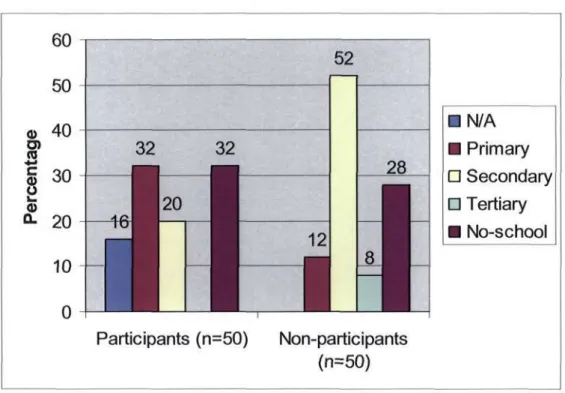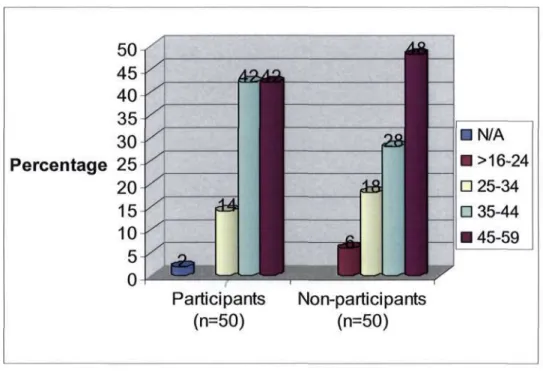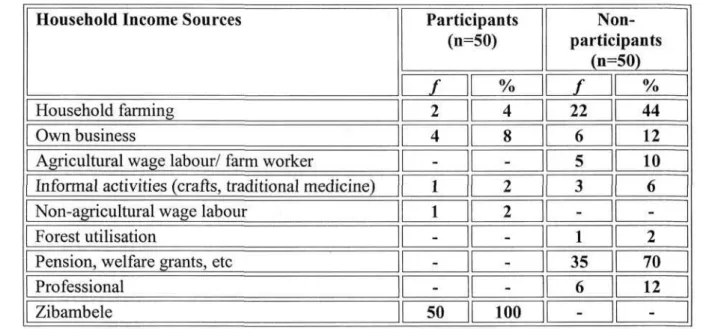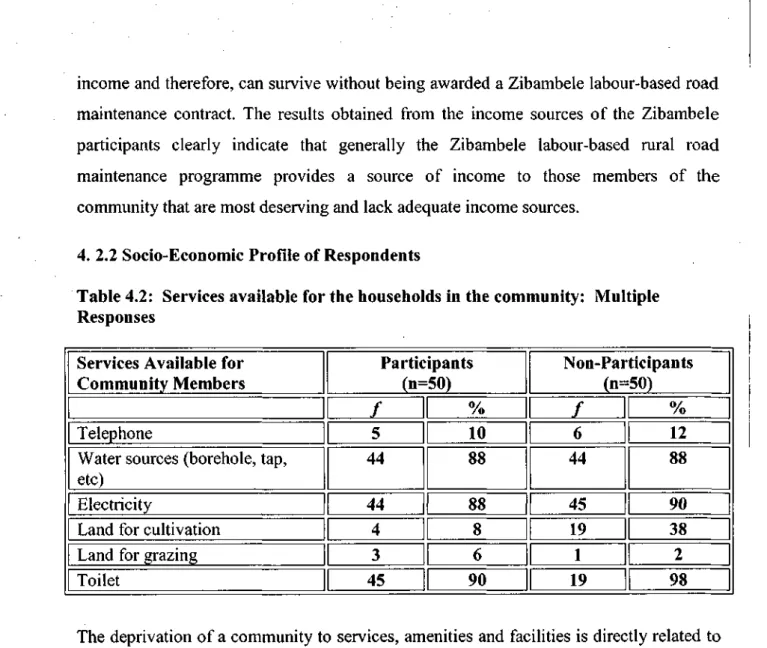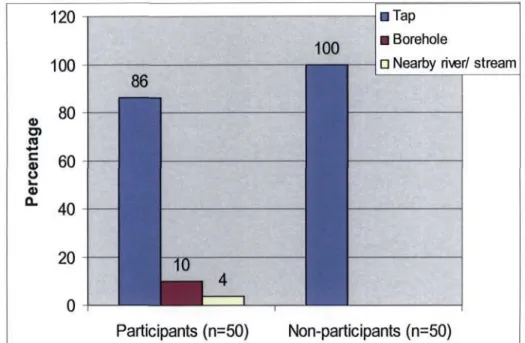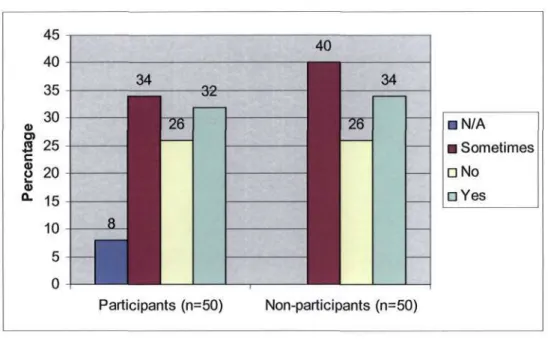Zibambele programme: More responses (participants) 156 Table 4.20: Expenses for the money earned by contracting with Zibambele. Answers (Participants) 164 Table 4.23: The impact of rain on the use of the road before the road could.
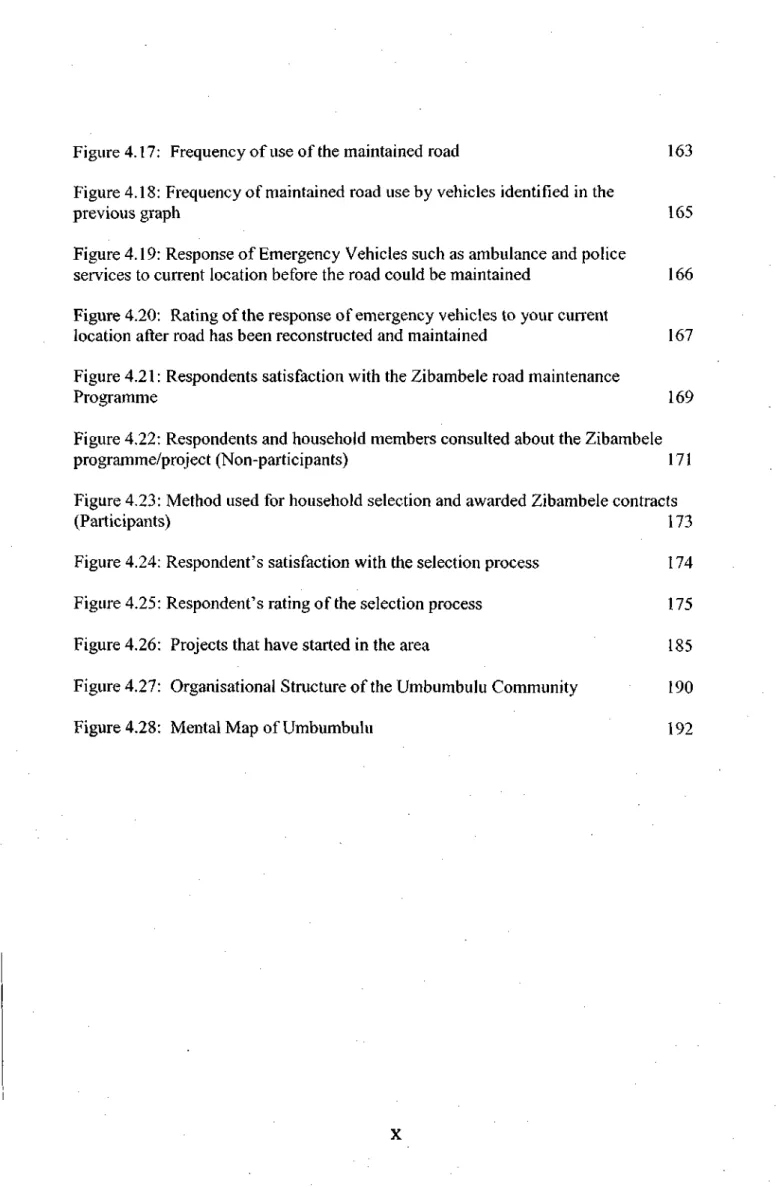
Motivation and Need for the Study
According to Beck (1994), if such a situation is left unchecked, it can result in the isolation of the rural poor Black population, thereby increasing their levels of deprivation and therefore poverty. This study aims to investigate the impact of the Zibambele road maintenance initiative on the livelihoods of the rural 'ultra poor' in the Umbumbulu community and how such a development strategy can be used for the social and economic upliftment of impoverished rural areas, as well as contributing to the empowerment of specifically female-led households.
Objectives of the research
Research Methods and Data Sources .1 Methodology
Primary data sources
Standard quantitative and qualitative methods will be used in the study to generate data related to the research objectives. The primary data sources used in the study include the use of socio-economic questionnaire surveys and qualitative methods.
Secondary data and information sources
Maxwell (1998) argues that quantitative methods produce numerical data that are usually machine readable and can be analyzed using recognized statistical tests and models. Qualitative methods result in textual or narrative information that is either descriptive or subject to other forms of analysis (Myers, 1997).
Chapter Sequence
Conclusion
Introduction
Definition of Concepts relating to the Research
- Development
- Sustainability and Sustainable Rural Development
- Rural Roads
- Unformed roads
- Formed roads
- Gravelled roads
- Provision of rural roads
- Stakeholders of rural road development
- Rural Roads and the Environment
- Rural Communities
According to Riverson et al (1991), the main stakeholders are usually considered to be local communities. According to Riverson et al (1991), road projects are examined in terms of their direct physical impacts on the environment (for example, effects on noise levels, air and water quality, soil erosion and flora and fauna) and impacts their indirect effects which are often socio-economic and/or cultural in nature (for example, effects on settlement patterns).
Poverty
Transport and Poverty
- Transport for Sustainable livelihoods
Inadequate infrastructure is an indicator of poor access to social resources. Hanmer et al (2000) argue that transport problems and the needs of the poor are fundamentally related to access.
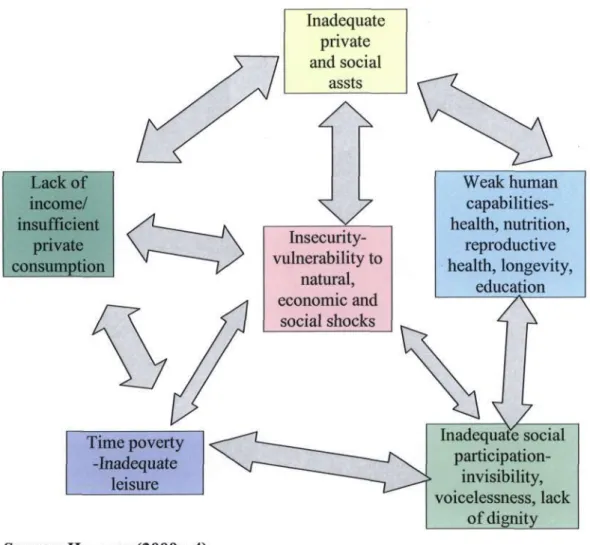
Transport and Gender
Women's transport needs are different from men's and women's and men's transport responsibilities are to some extent separated (World Bank, 2002). Women's triple burden (reproductive, productive and community management) determines women's transportation activities and needs.
Rural Transportation Infrastructure
Planning for Transport infrastructure
The first is low transportation density in low-income areas, with few motorized vehicles or intermediate modes of transportation. In such areas, transportation services have reached critical mass, making it easy to purchase and maintain various modes of transportation.
General History of Transport Infrastructure 1 Roads (Modern)
Improvements in trade and transport infrastructure are likely to drive mutually reinforcing changes in the trade sector. As defined in the previous section, one of the most effective ways to promote economic development is to build or improve rural road networks.
South African Poverty and Transport
Poverty in South Africa (Structural Legacy of the Economy)
Furthermore, the distribution of income and wealth in South Africa is among the most unequal. According to Lewis (2001), the economic and social status of women in South Africa was largely determined in relation to men.
Current Situation of South Africa's Roads
Hindson (2003) further argues that the legacy of apartheid accounts for much of the high incidence and persistence of poverty in South Africa. As such, it is a sector that cannot be allowed to lag behind despite the historical contradictions and current constraints facing South Africa.
Transport Policy
- The Reconstruction and Development Programme (RDP)
- Growth, Employment and Redistribution (GEAR)
- The White Paper on National Transport
- Moving South Africa (MSA, 1999)
- Integrated Sustainable Rural Development Strategy (ISRDS)
- Rural Transport Strategy for South African (RTSSA)
According to the GEAR Policy (1996), a tighter fiscal policy is needed to increase domestic savings from the extended impact of the stronger investment and export performance. The participation of the rural community in the Zibambele rural road maintenance program has facilitated many of the objectives of the GEAR policy. In relation to transport, the objectives of the ISRDS can be achieved through the participation of rural communities in labour-based jobs.
Women's Participation and Labour-Based Methods
Work-based methods require supervision and create significant local administrative and managerial opportunities for the educated and unemployed. According to Taylor (2000), women's participation in labor-based rural road maintenance activities can increase women's off-farm needs. Ndimande (2006) argues that women's participation in formal or informal employment plays an important role in economic growth and supplements family income.
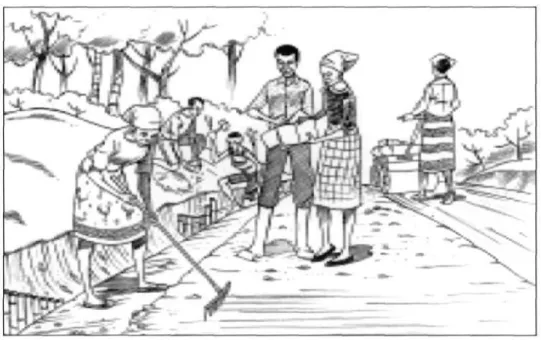
Labour-Based Methods using Lengthmen and Petty Contractors (Male or Female)
- The Lengthmen System
- Basic Causes of Deterioration of Rural Road and Maintenance using Lengthmen
According to the Minor Roads Program (1986), the system also makes it possible to carry out maintenance throughout the year on every section of the road. The longman contractor is a person who has been or is engaged in the construction and maintenance of the road. The officer in charge is responsible for the day-to-day management and functioning of the road network in the district.
Adverse Impacts of Road Improvements or Maintenance
The work shall consist of cutting all grass and shrubs on both sides of the road and for the entire width between the edge of the pavement and the top of the back slope of the road side drainage. Where roadside drainage exists on one side of the road only, grass and shrub cutting on the fill slope shall extend for a minimum distance of 2.5 m from the edge of the pavement adjacent to the embankment slope. Where there are no roadside drains, such as on road embankments, the cut should extend from the edge of the pavement to the foot of the embankment or to the water level in blocks on both sides of the road.
Maintenance Management
Tasks of the Maintenance Unit
Inventory: recording the list of roads and the basic characteristics of each section of the road network. Determination of maintenance needs: analysis of effects, their causes; and determining what maintenance activities are required to eliminate them and delay further deterioration. Planning and execution of works: time planning and supervision of execution of works, preparation of contract documentation, submission and supervision of maintenance contracts.
Routine Road Maintenance Policies
- Planning, Supervision and Monitoring
- Type of Contracts and Labour-based Rural Road Maintenance
Based on standards: The contract specifies the standards of certain road features to be maintained over a specified period. Quantity-based: The contract defines the exact amount of work for each element of the road to be maintained over a specified period. Lump Sum: The contract specifies the standards of certain road features to be maintained and the total amount of money (lump sum) that the contract covers over a specified period of time.
Costs related to Maintenance
Road Maintenance Funding and Institutions
Kumar et al (1995) argue that concerted efforts are needed to mobilize additional funds for rural road development. Insufficient Funding – Most government allocations for rural road maintenance fall short of the required amount. Road engineers and planners, together with the communities involved, must be aware of both the importance and consequences of improved rural transport (Touton, 2003).
Conclusion
The emphasis of the research is particularly on the contribution of labor-based rural road maintenance and its impact on the quality of life of rural families, as well as how the program contributes or affects poverty alleviation. Thus, the research methodology chapter is an attempt to identify and explain the research methods used in the case study of the Zibambele rural road maintenance programme. The chapter also provides a descriptive background of the study area and is followed by a review of research theories, paradigms and methods and their effect on the interpretation of research data.
Background to the case study
The Zibambele Programme
- Policy for Zibambele Road Maintenance Programme The purpose of the Zibambele road maintenance programme policy is
The Zibambele Road Maintenance System was launched in October 1998 at a meeting on employment as part of the Road to Wealth and Job Creation led by the KwaZulu-Natal Department of Transport (Zibambele, 2003). Bypasses must be maintained, 500m on each side of the road on roads carrying 0-400 vehicles per day with more than 15% heavy vehicles. On roads with daily vehicular traffic, one side of the road must be maintained for a total length of 1 km.
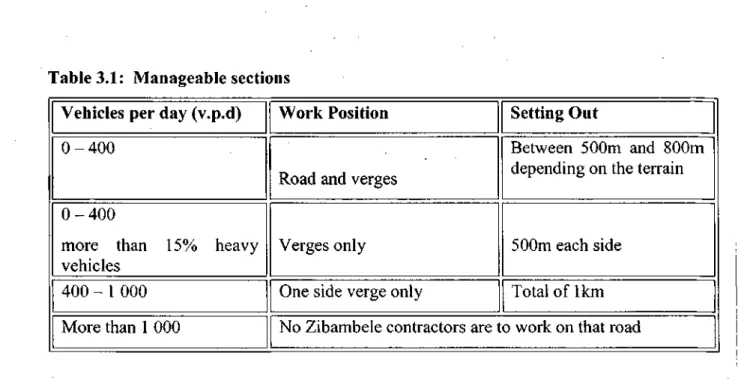
The Study Area Location and Characteristics
Other procedures contained in the Zibambele Policy (2003) document relate to the safety of the Zibambele contractor, claims against the Department of Transport (DOT), approval of the Zibambele contract, procedure for payment and the procedure for terminating the contract. Makhanya (1997) states that the Umbumbulu site is undulating, with an average annual rainfall of about 1,020 mm occurring mainly during summer when maximum temperatures are about 30 degrees Celsius. Oliver (2005) says that small subsistence farmers in this area were involved in the cultivation of indigenous crops such as maize, madumbe, sweet and baby potatoes, green beans and wild melons.
Research questions to be answered
Methodology
Participatory Research Methods
People participate by answering questions from extractive researchers using questionnaire surveys or similar approaches. People participate by providing resources, such as labor, in exchange for food, cash, or other material incentives. People participate by forming groups to achieve predetermined objectives related to the project, which may include the development or promotion of an externally initiated social organization.
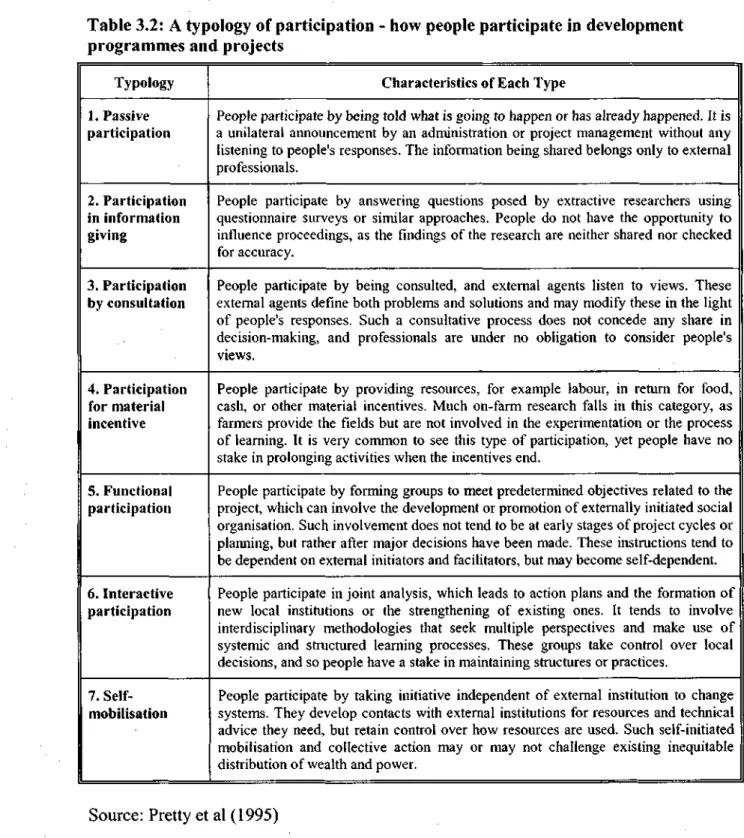
Participatory Rural Appraisal (PRA)
According to Chambers (1992), rapid rural assessment was developed in the 1970s and 1980s in response to the perceived problems of the absence of outsiders or miscommunication with local people in the context of development work. Therefore, the research conducted in Intinyane community in Umbumbulu employed the Participatory Rural Appraisal methods of data collection and analysis, including direct observation, focus group discussions, mental mapping, Venn/chapatti diagrams and ranking exercises. In relation to the research conducted in the Umbumbulu area on labour-related rural road maintenance for poverty alleviation, the Participatory Rural Appraisal (PRA) approach was used to collect qualitative data on community members.
Research Instruments
Secondary Data and Information Sources
Primary Data Sources
- Questionnaire survey
- Qualitative Methods
The researcher sent an invitation to the focus group discussion through the wife of the local Induna from the Intinyane community, Umbumbulu. The meeting was held in the early hours of the day and eight women attended. During the focus group discussion held in the Intinyane community, participants were asked to draw a venn/chapatti diagram illustrating the organizational structure of the community.
Fieldwork
Resource maps, for example, outline the layout of the village, showing the location of community infrastructure such as roads, schools, health centers and agricultural practices. The focus group discussion held in the Intinyane community involved mind mapping, where focus group participants were asked to sketch physical features such as roads, schools, residents, etc. Community fieldwork was also undertaken through focus group discussions that included participatory exercises such as drawing a venn/chapatti diagram, mind mapping and a community problem ranking exercise.
Limitations
The focus group discussion was conducted between the researcher, some women from the community and the Zibambele area manager.
Conclusion
This chapter also depicted the importance of making correct choices regarding the selection of the correct methods which are essential to meet the objectives of the study as well as to influence the end result of the research. This part of the thesis presents the findings from the research conducted on the socio-economic impacts of labour-based rural maintenance for poverty reduction. The chapter is an analysis of the data obtained during the questionnaire survey and includes the results obtained from focus group discussions, direct observations, the mental map created by the community members as well as an organizational structure within the community, in the form of a friend/.
Questionnaire Analysis .1 Introduction
Demographic Profile of Respondents Figure 4.1: Gender of Zibambele Participant
Twenty percent of respondents indicated that they were widowed due to unforeseen accidents, murders and factional struggles. 20 percent of the respondents indicated that they were able to go to high school but did not complete their studies. 20 percent of the respondents experienced no difficulties in obtaining, collecting or buying the building materials they need.
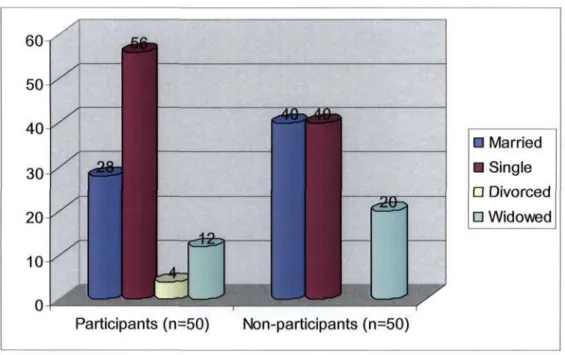
Accessibility of Closest Main Road
Eighteen percent of non-participants did not respond to the mode of transportation to go to church. Ten percent of participants did not respond to the time it took to get to the clinic. Six percent of non-participants did not respond to the time it took to get to the clinic.
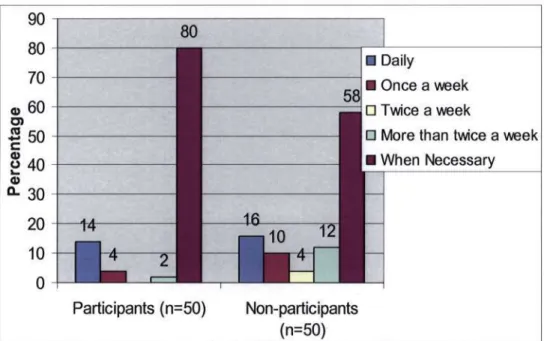
Zibambele Rural Road Maintenance Awareness
Sixty percent of non-participants indicated that response from emergency vehicles improved significantly after implementing the road maintenance program. Thirty-eight percent of non-participants said the response of emergency vehicles had improved slightly. Many respondents indicated that the condition of the roads was deteriorating rapidly before the implementation of the Zibambele programme.
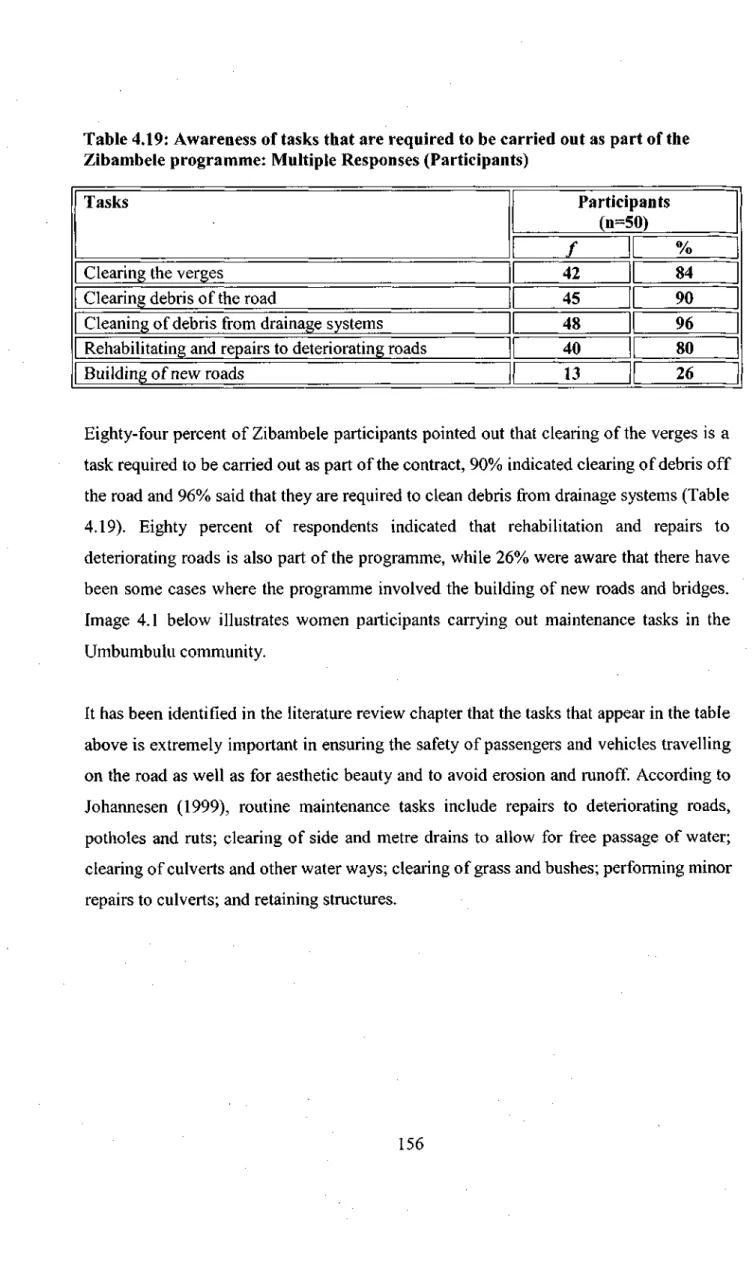
Zibambele Participants Perceptions on the Zibambele Programme and Poverty Alleviation Programme
Sixty-six percent of non-participants surveyed stated that the road was unusable due to rainy weather. All Zibambela participants and 92% of non-participants indicated that the community lacked facilities such as clinics and libraries. Ninety-eight percent of Zibambela participants and 84% of non-participants responded that community members lack skills training.
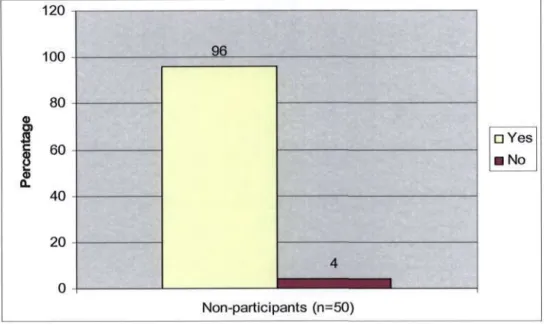
Direct Observation
